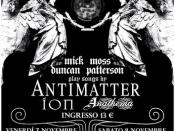Anti-Matter Introduction Ordinary matter has negatively charged electrons circling a positively charged nuclei. Anti-matter has positively charged electrons - positrons - orbiting a nuclei with a negative charge - anti-protons. Only anti-protons and positrons are able to be produced at this time, but scientists in Switzerland have begun a series of experiments which they believe will lead to the creation of the first anti-matter element -- Anti-Hydrogen. The Research Early scientists often made two mistakes about anti-matter. Some thought it had a negative mass, and would thus feel gravity as a push rather than a pull. If this were so, the antiproton's negative mass/energy would cancel the proton's when they met and nothing would remain; in reality, two extremely high-energy gamma photons are produced. Today's theories of the universe say that there is no such thing as a negative mass. The second and more subtle mistake is the idea that anti-water would only annihilate with ordinary water, and could safety be kept in (say) an iron container.
This is not so: it is the subatomic particles that react so destructively, and their arrangement makes no difference. Scientists at CERN in Geneva are working on a device called the LEAR (low energy anti-proton ring) in an attempt to slow the velocity of the anti-protons to a billionth of their normal speeds. The slowing of the anti-protons and positrons, which normally travel at a velocity of that near the speed of light, is neccesary so that they have a chance of meeting and combining into anti-hydrogen. The problems with research in the field of anti-matter is that when the anti-matter elements touch matter elements they annihilate each other. The total combined mass of both elements are released in a spectacular blast of energy. Electrons and positrons come together and vanish into...


